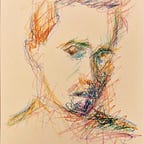“The Teddy Cross” — Where Service Design meets Interaction Design
I have often asked my self, what do I do for a living? I know I am a service designer, that started out as an interaction designer, but what is the difference between the two, when did I cross that line, and is there a line? Me and my colleagues have this discussion all the time.
I work at a consultant agency called Sopra Steria, which have some of the most tech-savvy, impressive professionals I’ve ever met. Many of the clients I’ve encountered have worked with designers before, but never with a service designer, so I try to explain what I do to the best of my capability. The weird part is that I often find it quite difficult. It got all the more complicated when a client asked me “Well, what is the difference between service design and interaction design?”. I knew there was a difference. I just didn’t understand how to explain it. I like to think visually, so I grabbed a piece of paper and drew up a line.
“Well, I tend to think of Service design as being in the beginning of a project, and then comes interaction design.” is my usual response. That being said I understand that service design goes beyond the technical side of a project. This article is meant to focus on service design within IT development projects.
The thing is that Service design is what I like to call human centered business development. The difference is this; Where the business consultant asks “What is best for our business?”, a service designer ask “What is best for our users?”. I am not saying that one is better that the other. On the contrary, I say that we need both, in parallell, working together.
So let’s start of with these four roles. I have deliberately left out a project manager, budget and business consultants, technical testers, graphic designers and many others. I am aware that they all are crucial for a successful implementation and launch of a new product, but I will have to involve them at a later point.
Lets say that the model above represents a project from start to finish. When does Service design and Interaction design meet?
Right there. To my experience, in heavy technical development project service design have a function to uncover the combined need of both the user and the business, and look at how to link the expectation of the user and the planned offering of the business together. Please note that in my ideal portrayal of a project both interaction and service design is involved in the entire duration of a project.
At the “Teddy cross” of the project, the interaction design role becomes more important in order to transform the needs of the user into user friendly, intuitive and awesome digital experiences. Very often, the Teddy Cross appears when the user stories are presented in the project.
So why is it so important to involve service designers from the beginning? Even though my experience is short, I have leared this the hard way already. I was hired together with a another interaction designer from Oslofjord Design & Illustration to do interaction design at a project where a collection agency tried to relaunch their online case registration tool, in order to get their clients to register more claims. The interface was awful, so we fully supported the decition to give it a full makeover. How ever, we asked to do some user interviews and observing their clients. We were allowed to do so, and where given a few days preform the user research. What we found was that yes, the users hated the website, but even more importantly they either didn’t understand what the collection agency could do for them, or that they didn’t want to register any collection claims. We talked to both small startups and bigger accountant firms, and the thing was that the accountant firms clients didn’t want them to launch a claim, as they felt that was too intruesive. One guy we interviewed even said;
“When it is just a few thousand dollars, I’ll probably let it go. I feel so bad on my customers behalf!”
Bringing back this research to the project manger, with some suggestions on how new clients could be informed about the role when signing a deal with the collection agency, or how to communicate the benefits of registering a case early, and a few other suggestions, his jaw dropped. They had no idea that the issue was the emotional aspect of the service offering.
This story illustrates business developers need to understand people. That being said, service designers also needs to understand business. Therefore the perfect combination is to have service designers, economists and business developers working together from the beginning.
This final model illustrates both the similarities and the difference between service design and interaction design. Both design diciplines are about people, but they both work with professionals that have their minds in either business or technology. And this combination is golden. I cannot state how important I think it is to have dedicated people that occupies all these roles within a project.
To answer the question I started out with; is there a line between interaction and service design? In my case, there was an overlap, and I managed to locate it though practical experience, valuable discussions and visual thinking.
So why is it called the “Teddy cross”? Well, it is nothing complicated, I tried to explain the model to a usability tester collague of mine, and instead of gesturing like a mad person, I drew it, and she said “Oh, so this is the model, Theodor? A Teddy cross?”.
